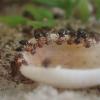I was walking my dogs thru the neighborhood, thinking how much I'd like to get a myrmecocystus species, especially m. mexicanus, when I looked down and saw a golden ant. I said, holy sh*t! I picked her up and sure enough, that's what she was. Maybe I'm spending too much time thinking about ants, but it was pretty weird.
But I had to get the dogs walked, so set her back down on her way…came back later and unable to find her colony. She was next to a brick planter, a lot of agave type cactus crowded together, and large pebbles all over the dirt in a small yard. I have never seen m. mexicanus in the hood, it's dominated by acromyrmex. Any experience on what these colonies look like?
















